Political Communication Summer Series #1
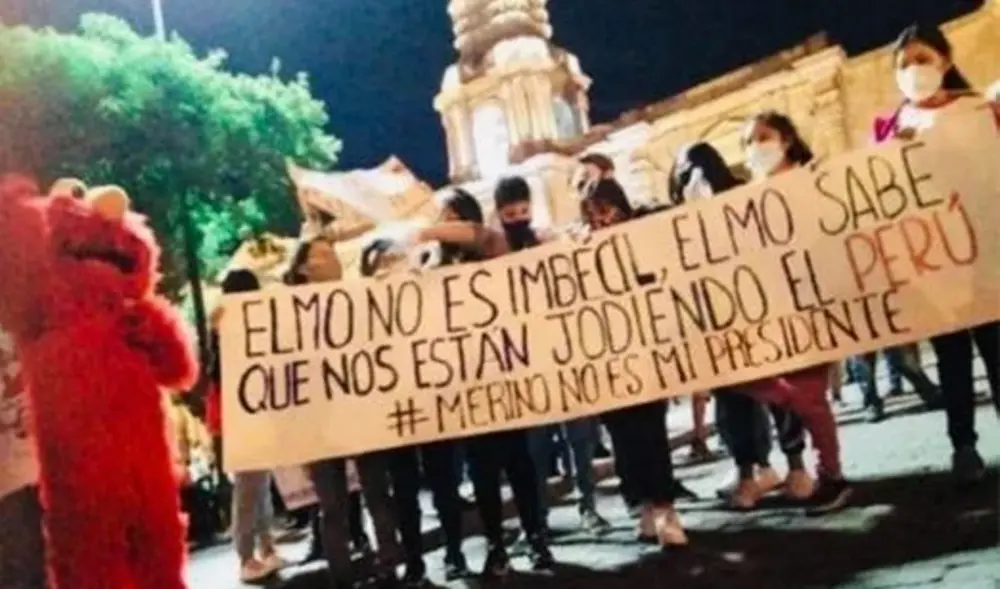
Today, the Bulletin Editorial Team is happy to kick off our summer series with policy briefs written by MPP students on topics of political communication in different settings worldwide. The articles are the result of a MPP course taught by Dr. Hasnain Bokhari in the summer semester. The course introduced fundamental concepts of political communication in highly interactive sessions. The six policy briefs will be published in couples of two, i.e. via three blogposts, so make sure to a) scroll down to not miss the second one of the day and b) tune in on Thursday and Friday of this week, as well, for parts 2 and 3 of our series.
Enjoy the break!
Florian and the Bulletin Editorial Team
1. MODERN POLITICS: Memes and young activism in Peru (Author: Patricia María-Fernanda Caparó Beltrán)
With the erosion of the internet and social media, the way of thinking about politics changed around the world, allowing individuals to find spaces to connect and engage in political debates through communities of interest (Manzini, 2019). Actors, who had been traditionally left out of the institutional conversations on politics, found a venue to share their opinions, challenge the government, and express their satisfaction or discontent with the way politics are conducted in their countries. Peru was not the exception.
Furthermore, digital platforms allowed for young people to join political discussions, with fresh perspectives and with less formal manners, mainly through the use of social media and visual politics tools such as video and image memes (Harbo, 2022). However, how exactly are memes used as a political tool by the Peruvian youth? And, why are they relevant for the broader political spectrum? Using the example of the protests of 2020 against then-President, Manuel Merino, the following article will seek to answers said questions.
The rise of memes in vernacular politics
In order to understand the role of memes in vernacular politics among the Peruvian youth, it is necessary to first define what we understand as a “meme”. Memes can be described as units of culture and behaviour that are transmitted among a society (Metahaven, 2013; Alexander, 2023). They can have many forms, including “traditions” such as the Happy Birthday song, or determinate hand gestures for specific situations.
Internet memes are also units of culture. Nevertheless, as Alexander (2023) notes, they have some particular characteristics that make them unique. One of them is their temporal and situated nature. Internet memes are usually inspired by social contexts, reflecting the author's point of view of a particular situation, which also makes them temporal, as they are intended to be short-lived, for as long as the event they refer to remains relevant. More importantly, the visual impact of internet memes is one of its more interesting features, since it makes it easier to be remembered, and accepted —as well as enjoyed— by the viewers. A further characteristic of internet memes is that they are highly democratic, in the sense that everyone with access to internet can create, view, react and share them, making them open to all generations and communities around the world.
Internet memes can take up many forms, such as text, emoticons, videos, GIFs, or others (Beskow et al., 2019), being the most common the presence of an image accompanied by a satiric text or a joke.
Due to their accessibility, both in the making and to understand them, memes have become an integral tool for visual politics, being used by citizens to communicate their opinions and express political statements (Venetti & Rovisco, 2023). On the other hand, they also work as a gateway to understand vernacular politics since they are often created by “the common citizen”, who is in touch with the sentiments of the masses, and finds memes as a way to reimagine politics in a playful, humorous, way (Changas, et al., 2019; Mortensen and Neumayer, 2021). Furthermore, the anonymity of memes provides a safe space that allows for an uncensored expression of political views, opening the doors for controversial and unpopular opinions without fear of negative consequences (Hristova, 2014; Ross & Rivers, 2017).
The impact of memes does not stay solely on the digital space. As a visual politics tool, memes transcend the boundaries of the internet and can turn physical, being found on signs, as graffiti on the streets, on different merchandise, among others (Xiao Mina, 2019). In the longer term, memes also become part of the political narrative, gaining responses from society and even working as a tool for mobilization (Xiao Mina, 2019). Even in protests, internet memes work as an embodiment of the demands of a community, taking on the role of political posters (Metahaven, 2013).
Despite the discussion on the role of internet memes in politics being mainly focused on the western society, it is important to note that there are also widely used in what is traditionally referred to as “the Global South” (Changas, et al., 2019; Xiao Mina, 2019; Venetti & Rovisco, 2023). One example of the use of internet memes, and its transcendence to the political discussion and the physical world, with their use in protests, can be analysed through the use of memes by young Peruvians in the protests against then-President, Manuel Merino, that took place in November 2020.
Memes and young political activism in Peru
The use of memes in political activism in Peru is not a recent development. The first relevant appearance of internet memes in the political debate can be traced back to 2013, where two main events inspired internet campaigns to express discontent with the political situation of the country: the intent to revoke the then-major of Lima; and the corruption scandal in implementation of a policy for traffic control (Castro Pérez, 2019). In this sense, from 2013 onwards, memes became a tool of political communication in Peru, being present to critique electoral candidates, react to national controversies, and even cope with both national and international hardships, such as the COVID-19 pandemic.
The use of memes became a way of passive political activism, and a way for citizens to participate in the political debate. However, things changed in November 2020.
Amidst the Covid-19 pandemic, ex-President Martin Vizcarra was impeached, adding a layer of political instability to the already unstable economic and social conditions, product of the pandemic. Manuel Merino, then-President of the Congress, took office. The population, mainly the young people, felt betrayed by a Congress that prioritized its own interests over the general well-being of the country, and protests quickly erupted, asking Merino to step down. It was in this context of manifestations, that the power of social media – and memes— in the political culture among young Peruvians showed itself. The turnout to the protests and the resilience of the people were very unexpected by both the society and the political class, since Peru, unlike other Latin American countries, had not —up to that point— had a strong culture of protests (Delgado Pugley, 2020).
Later studies of the protests of November 2020, have shown that about 13% of Peruvians joined the mobilizations, i.e. about 4 million people, with the majority of them being under the age of 27 years old (Gonzales-García & Murguerza, 2022). Moreover, the protests took place in multiple scenarios, with people taking to the streets to physically demand the resignation of Manuel Merino, while also making use of digital platforms by sharing videos and pictures of the mobilizations or memes about the political situation on social media for those who either couldn’t or didn’t wish to join the physical manifestation (Delgado Pugley, 2020).
More than 30% of the protestors used social media platforms, mainly Twitter, Instagram, and TikTok, to share their opinions on the political situation, inform about the abuses suffered during the protests, and convey social indignation about the general political landscape of the country, both through text and images, i.e. memes (Delgado Pugley, 2020; Gonzales-García & Murguerza, 2022). Along their informative role, memes also played a part in motivating the citizens, especially young people, to join the conversation and express their indignation; “social networks helped activists to frame problems, propagate symbols and transform online activism into offline protests using human and material resources” (Gonzales-García & Murguerza, 2022: 156).
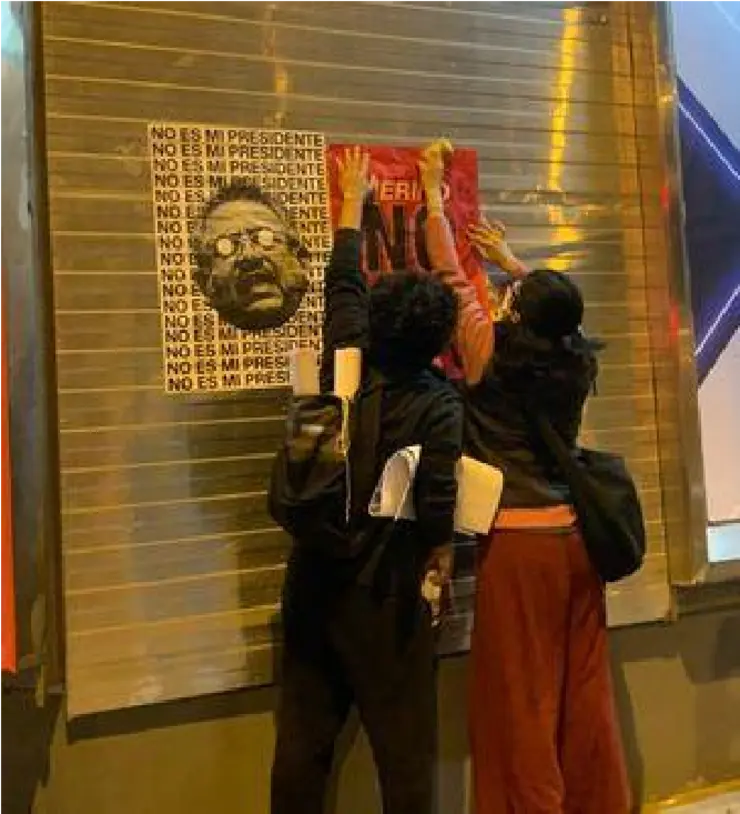
“Social media had empowered disillusioned citizens by giving them a voice that could not be ignored” (Rebaza, 2020); working as a venue to share their own experiences and versions of the events, in response to the traditional media coverage of the protests. A lot of this was done through memes, from images of then-President Manuel Merino covered by the message “Not my President” (No es mi presidente), to memes using 1990s and 2000s cartoons images to express a satirical message of the situation, such as Sponge Bob, The Fairy Godparents, Pokémon and Sesame Street. The images chosen also reflected the target audience, since the scenes were recognizable to the people who had grown up watching said cartoons, making the political messages not only understandable but also relatable. Said images did not stay in the digital platforms, they were printed or drew and made into posters, making the protest very colourful and humorous (Chávez, 2021). People would even dress up as the main characters from the most popular memes, such as Pikachu, the joker, and even dinosaurs, which were used as a metaphor to criticize the outdated point of view of the current political generation of the country (Chávez, 2021).
One of the many memes used was the internationally-recognized “Elmo Rise” meme, where the character from Sesame Street —Elmo— is seen lifting his arms, with fire in the background. Usually, this meme is shared among young people to express that a situation is “about to catch fire”, be it in the sense of an escalating drama or an imminent conflict. In the protests of November 2020, Elmo was a common presence, with many young people renting out costumes of the red character and re-enacting the meme. Others, used footage of Elmo in the protest to make videos directed to Merino, with the catchphrase “Elmo knows where you live” as a background sound, which was popularized by the TV-series, “The Simpsons”; and turned into a main meme during the 2020 Protests in Peru (Infobae, 2022).
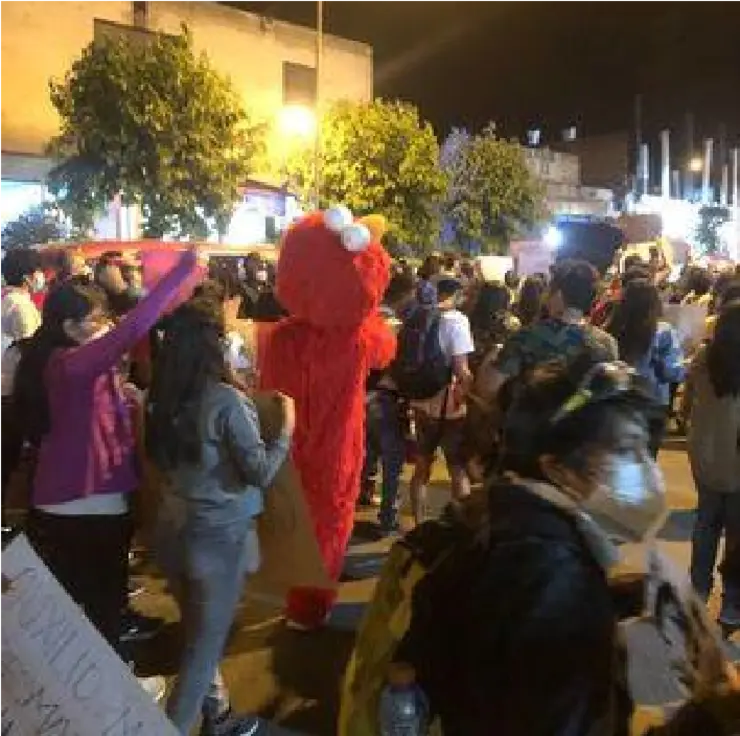
In summary, memes have long been a tool for everyday politics in Peru, offering a way to engage in conversation and express opinions about the political situation of the country, as well as react to both national and international events. However, their importance reached an all-time high during the protests of November 2020, where they were used not only to incentivize young Peruvians to engage in the political discussion, while making the debate more accessible and relatable to them, but also to convey their demands in the physical arena, transcending the digital platforms and giving a new spirit to the manifestations.
Conclusion
“Memes can be silly, they can be harmless, they can be destructive, they can be extremely serious, and they can be all these things at the same time” (Xiao Mina, 2019: 16). As a tool for visual politics, memes have also become a pivotal part of vernacular politics, expressing the main sentiments of the masses and offering a way to participate in the political debates, making the information more accessible and allowing to react in real-time without fear of repercussions.
In the Peruvian case, memes have been a part of the everyday political discussion since 2013, being a way to criticize political decisions or call attention onto corruption scandals. However, it wasn’t until November 2020, with the protests against then-President Manuel Merino, that memes showed their true power in not only informing young Peruvians and allowing them to perform political activism online, but also in organizing them to mobilize and to share their demands, taking the main memes into the physical realm.
In conclusion, memes are proving to be an important tool in vernacular politics to both inform young Peruvians through visuals and allow them to do activism from home. After all, as Shepherd (2018) points out: “Politics happens also in the street, in the kitchen; it can be laid bare in internet memes, coffee cups and architecture. Politics surrounds us, constituting everyday lives.” (p. 213).
References
ALEXANDER, G. (2023). Smile! It's only Covid: Analyzing covid-19 internet memes. Journal of Creativity, Volume 33, Issue 1. doi.org/10.1016/j.yjoc.2023.100049.
BESKOW, D., KUMAR, S. & CARLEY, K. (2019). The Evolution of Political Memes: Detecting and Characterizing Internet Memes with Multi-modal Deep Learning. Information Processing & Management. 57. 102172. doi.org/10.1016/j.ipm.2019.102170.
DELGADO PUGLEY, D. (2020, December 14). How did Peru resist a coup d’état? Reflections on popular mobilization against authoritarianism. www.gicnetwork.be/how-did-peru-resist-a-coup-detat/
CASTRO PÉREZ, Raúl. (2019). «Quería probar que puedo hacer tendencia»: activismos ciudadanos online y prácticas poplíticas en el Perú. Anthropologica, 37(42), 177-200. https://dx.doi.org/10.18800/anthropologica.201901.008
CHAGAS, V., FREIRE, F., RIOS, D., & MAGALHAES, D. (2019). Political memes and the politics of memes: A methodological proposal for content analysis of online political memes. First Monday, 24(2). https://doi.org/10.5210/fm.v24i2.7264
CHÁVEZ, N. (2021, January 5). Peru: tiktokers, memes and tear gas. vistprojects.com/en/peru-tiktokers-memes-and-tear-gas/
GONZALES-GARCÍA, C. & MURGUERZA, M. (2022). Generación del Bicentenario: movimientos juveniles contra el expresidente Merino. Universitas: Revista de Ciencias Sociales y Humanas de la Universidad Politécnica Salesiana, Núm. 37. doi.org/10.17163/uni.n37.2022.06
HARBO, T.F. (2022). Internet memes as knowledge practice in social movements: Rethinking Economics’ delegitimization of economists. Discourse, Context & Media, Volume 50. doi.org/10.1016/j.dcm.2022.100650.
HRISTOVA, S. (2014). Visual Memes as Neutralizers of Political Dissent. tripleC: Communication, Capitalism & Critique, Volume 12, Nr. 1. Pp. 265-276. doi.org/10.31269/vol12iss1pp265-276.
MANZINI, E. (2019). Politics of the Everyday (trans. Rachel Anne Coad). Bloomsbury Publishing Plc.
METAHAVEN. (2013). Can Jokes Bring Down Governments? Memes, Design, Politics. Strelka Press
MORTENSEN, M. & NEUMAYER, C. (2021). The playful politics of memes, Information, Communication & Society, 24:16, 2367-2377, DOI: 10.1080/1369118X.2021.1979622
NEWSROOM INFOBAE. (2022, April 22). “Elmo knows where he lives”, the meme that came to life during the marches in Peru. www.infobae.com/en/2022/04/22/elmo-knows-where-he-lives-the-meme-that-came-to -life-during-the-marches-in-peru/
REBAZA, C. (2020, November 23). ‘They messed with the wrong generation’: How young people shook up politics in Peru. CNN. edition.cnn.com/2020/11/23/americas/peru-president-youth-movement-intl/index.html
ROSS, A.S. & RIVERS, D.J. (2017). Digital cultures of political participation: Internet memes and the discursive delegitimization of the 2016 U.S Presidential candidates. Discourse, Context & Media, Volume 16, pages 1-11. doi.org/10.1016/j.dcm.2017.01.001.
SHEPHERD, L.J. (2018). Militarisation. In: Bleiker, R. (Ed.) Visual Global Politics. Routledge.
VENETI, A., & ROVISCO, M. (2023). Introduction to Visual Politics in the Global South. In: Veneti, A., & Rovisco, M. (Eds.). Visual Politics in the Global South. Springer Nature.
XIAO MINA, An. (2019). Memes to Movements: How the World's Most Viral Media Is Changing Social Protest and Power. Beacon Press.
2. Social Media Discourse, Memes and its effect on free speech in India (Author: Shreesh Karmarkar)
Think about India, a country with over 1.4 billion citizens to call it their country, 788 representatives from Lok Sabha (the lower house) and Rajya Sabha (Upper House) of the Parliament; the world’s largest experiment of nation building and democracy, indeed the world's largest democracy and according to the preamble to the constitution, constituted into a sovereign, socialist, secular, democratic republic.
A marvellous experiment indeed, however, as per the Reporters Without Borders (RSF), India ranked 140 out of 180 countries in their global rankings in 2014, when the current Prime Minister of India, Narendra Modi won the election. And today, in 2023, a staggering 9 years later, India’s rank has slipped to 161. Just a year ago, in 2022, the RSF ranked India 150th out of 180 countries. This means that India has worsened in the tolerance of free speech.
India is among the world's most hazardous countries for journalists seeking to do their jobs correctly, according to RSF research (2021). The "Liberty of Thought, Expression, Belief, Faith and Worship" guaranteed by India's preamble has been slowly eroded as attacks against journalists have increased over the past decade since Modi came to power.
The best illustration is without a doubt the Reliance Industries group, which is headed by Mukesh Ambani, who is now a close to the PM (Prime Minister) Modi’s administration and controls more than 70 media sites that at least 800 million Indians watch. Similar to this, the end of pluralism in the mainstream media was heralded by Gautam Adani, a businessman who is connected to Narendra Modi, taking control of the NDTV channel by the end of 2022. (India | RSF, 2023)
The Internet remains the only seemingly free place where dissent against the government can exist. Even that being said, The nation is known as the "internet shutdown capital of the world".
It is very clear that Social media discourses form an integral part of the free speech that the Indian government is trying to actively censor, however, the question remains, whether it can have any impact on Free speech or not. The dissent on social media mainly can take place in the forms of social media posts, message threads, and most innovatively, memes. Therefore its important to investigate whether the phenomenon of memes, that is very avidly indulged in social media, especially by India, does have an impact on Free speech in India or not.
Here on the blog post shall try to focus on memes as a topic mainly because the memes are very much a viral phenomenon and have a tendency to catch on to social media trends that can serve to amplify the certain political message associated with them.
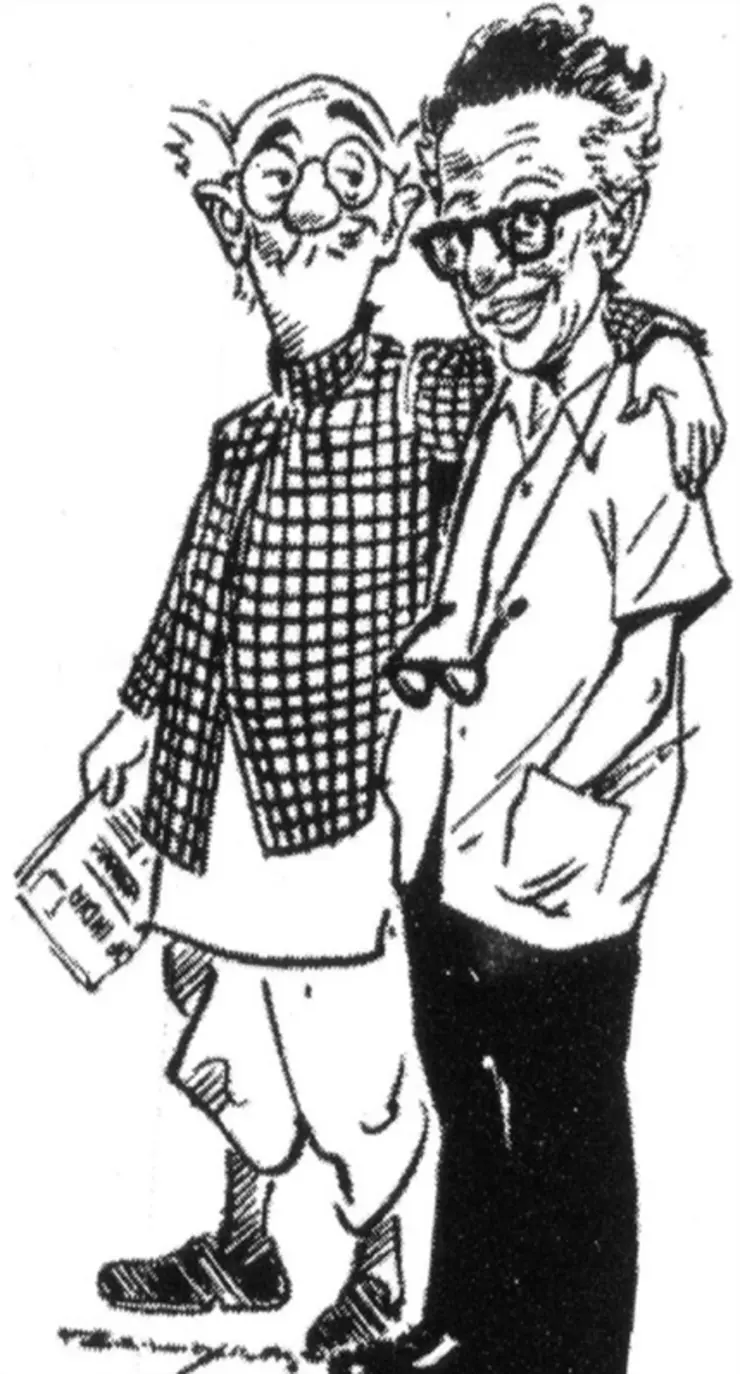
India’s history with Visual Politics:
India has had a rich history of visual politics, especially regarding dissent. Ranging from visual cartoons, caricatures, posters, and even going to wall paintings movies. A trip down the memory lane shall help us to understand India’s true diversity in visual politics.
It was 1951, when RK Laxman, the celebrated cartoonist, introduced “The Common Man” a stock character that later grew up to encompass the identity of the common man of India. His segment, “You Said It” in The Times of India became a hit from the very same moment.
Clad in a simple dhoti, and a chequered jacket, his balding head and spectacles have had the intense rays of scrutiny that made the governments in power realise that the common man can see the shuffles behind the curtains of political power. The slight comments on corruption as well as the ever present bewildered look on his face made “The Common Man” an icon of Indian democracy. The Common Man, if present in real life today in India, would continue to have his characteristically bewildered look on his face, depicting his disenchantment with politics. (Khanduri, 2012).
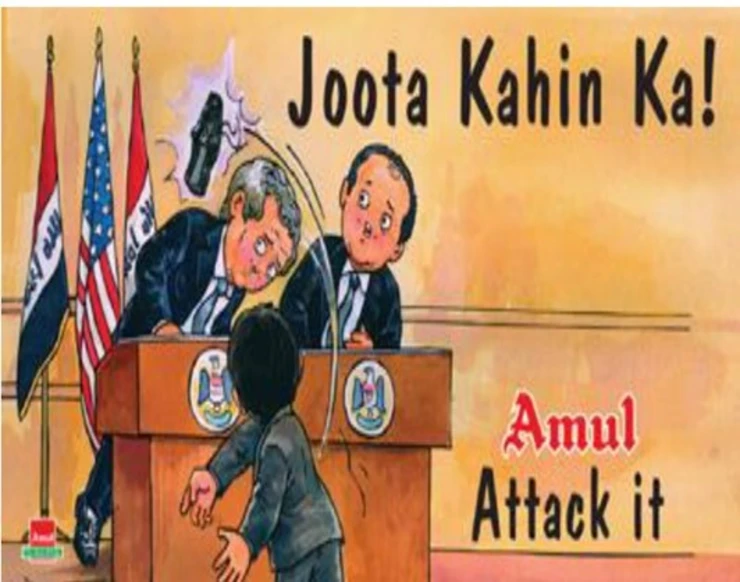
Another example of notable visual politics is the Amul Girl created by the famed Ad-Guru Sylvester De Cunha. The Amul girl is a manually drawn cartoon depicting a little Indian girl with blue hair, a half-pony pulled up, and a polka-dotted gown. Sampled as one of the most creative styles of Indian advertising, the Amul girl is also involved in a lot of political communication regarding issues regional, national and international (Mamidi, 2018).
Noteworthy to mention is the fact that although the Amul mascot girl has been mobilised for political communication, it has not openly taken an anti government stance but immortalised the current events in the form of puns, making a catchy tagline to events, as well as the dairy brand of Amul. (Nair & HS, n.d.)
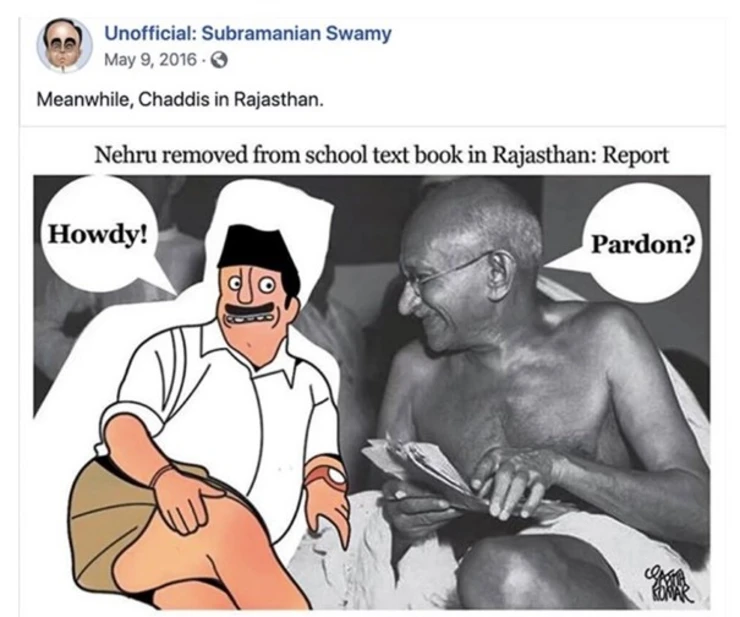
Meme and it’s importance viz India:
To define memes, A meme is an idea, action, or fashion that circulates among individuals within a society through imitation and frequently has a meaning of its own, expressing a particular circumstance or subject. A meme serves as a container for cultural concepts, images, or behaviors that may be passed from one individual to another orally, in writing, through body language, gestures, rituals, or by other imitable events with a replicated theme. (Benveniste, 2022) At present, India has 61% of social media penetration within the society, a number that is set to advance as per the passage of time. This makes it clear that many citizens do use social media, and by extension, many citizens are at least at the receiving end of memes. It needs to be seen how memes impact political orientation in India mainly because in light of current events, social media is seen by many as a medium of amplifying the voices of dissent.
And such was the use of memes and social media in the Farmers Protest of 2021, where social media helped amplify the voices of dissent, and helped spread the message of the protest internationally. With regards to visual politics, the unfurling of the Sikh religious flag, the Nishan Sahib at the Red Fort in Delhi, became one of the most iconic pictures of the Farmers protest causing mass controversy.
Focus on memes now, mainly to check whether their tendency of being a viral phenomenon and replicability do cause some active change in India’s democracy or not. Research also found out that the 2019 General elections in India were not influenced by social media or memes. (Sen, R., Naumann, K., & Murali, V. S. (2019, December 18) find out that BJP (the ruling Bharatiya Janata Party) would have won the elections even without the usage of social media. Needless to say, the eventual victory of the BJP gave rise to a lot of memes, however, because of ever present distortion of facts in the memes, social trust on social media memes remains low.
Critique against the current ruling Indian right wing as seen in memes is as follows (Figure 3).
And that is seen in research. Kulkarni, 2017, suggests that social media memes does not cause a paradigm shift in people’s personal opinions, because, “Memes are considered as humor, to comment on a person, idea, ideology in a sarcastic manner. They are still not given importance as the content generated by traditional media as the audiences know it is used to comment negatively” According to her, the impact of memes, in order to change voting behaviour, political ideologies and political opinions of the people. But Baishya (2021) proceeds with the thought that all that memes do is elicit a response. They might not change a policy, or change governments thoroughly, but their potent capacity lies in conveying the precise contexts to their enjoyers and viewers. In doing so they subtly persuade the viewer, by default pushing forward the public discourse. This is something supported by Dr. Joan Donovan who, in her book book, Meme Wars: The Untold Story of the Online Battles Upending Democracy in America, explains that memes form an important ‘way’ for popular culture to manifest itself to the masses. Memes, as a sociological phenomenon, readily make themselves available for discourse to exist. All one needs for its (it being any popular idea/opinion/discourse) propagation is photoshop skills, and basic minimumn software requirements for basic photoshop (TechTank Episode 64, n.d.). As one sees in the images of Figure 6 and 7, Memes are very much a replicable phenomenon, can be rewritten and reworked upon. Allowing rapid transformity from their original image and intended use. (Image 6’s original image is very much a rework from the photo of Jawaharlal Nehru and Mahatma Gandhi, and Image 7, is simply Frankenstein with a saffron scarf, and a saffron tilak- a mark denoting sectarian belonging.) Dr. Joan Donovan, who is the research director of Harvard Kennedy’s Shorenstein Center and the director of the Technology and Social Change (TaSc) Research Project, also stresses on the transgressiveness of memes, apart from their replicability, making it an effective means of communication for the wider masses, of every political affiliations (TechTank Episode 64, n.d.).
Conclusion
As seen above, memes remain to be an important factor of free speech in India, however negligible their role might be at the greater play of things. Another thing to note is that with current events, eliciting that the Modi Government threatened Twitter to delete the content produced by journalists against the official policy during the Farmers Protests, and raid employees’ homes and shut Twitter India, the current proposed amendments to the 2021 Intermediary Guidelines and Digital Media Ethics Code strengthen the government’s grip on social media platforms.
An explanation to the receding freedom of speech in India can be the following words by Stuart Croft in his Images and Imaginings of Security (2006) “the focus on the state in the production of security creates silences, places where security is produced and is articulated that are important and valid, and yet are not usual in the study of security”. Censoring social media creates a similar produced sense of security where silence is the norm and memes try to be a small crack in the silence pushing political discourse, and engaging people on the basis of contexts, sub texts and imagery.
With respect to all the talk about memes as of now in the blog post, here’s also where the earlier mentioned repression in India forms an interactive way of repressive politics. Recently, the government has resorted to arresting the memers, as making examples out of them, to discourage others from making memes (The Wire Staff, 2021) (PTI, 2022). But even in doing so, memes themselves dont disappear from the internet. They, by the virtue of being memes, get replicated, duplicated and carry on ahead with a different characteristic. A true plant of free speech growing in the cracks of government imposed censorship. Memes, in that way, impact democracy by being a means to communicate.
References
All you need to know about Nishan Sahib, the flag hoisted by farmers on Red Fort. (2021, January 27). Hindustan Times. https://www.hindustantimes.com/india-news/all-you-need-to-know-about-n ishan-sahib-the-flag-hoisted-by-farmers-on-red-fort-101611743152798.ht ml
Baishya, A. K. (2021). The conquest of the world as meme: Memetic visuality and political humor in critiques of the hindu right wing in India. Media,Culture & Society, 43(6), 1113–1135. https://doi.org/10.1177/0163443720986039
Benveniste, A. (2022, January 26). The Meaning and History of Memes. The New York Times. https://www.nytimes.com/2022/01/26/crosswords/what-is-a-meme.html
Croft, S. (2006). Images and Imaginings of Security. International Relations, 20(4), 387–391.https://doi.org/10.1177/0047117806069399
Gurera. (2015). English: A tribute to the legend cartoonist Late R K Laxman (24 October 1921-26 January 2015) by Cartoonist Shekhar Gurera. Own work. https://commons.wikimedia.org/wiki/File:Gurera%27s_Tribute_to_Laxman. jpg
General Elections 2019: Memes flood social media after the results. (2019,
May 24). The Hindu. https://www.thehindu.com/sci-tech/technology/general-elections-2019-me mes-flood-social-media-after-the-results/article27235593.ece
India | RSF. (2023, June 21). https://rsf.org/en/country/india
India: Social network penetration 2028. (n.d.). Statista. Retrieved July 16, 2023, from https://www.statista.com/statistics/240960/share-of-indian-population-usin g-social-networks/
Khanduri, R. G. (2012). Picturing India: Nation, Development and the Common Man. Visual Anthropology, 25(4), 303–323. https://doi.org/10.1080/08949468.2012.688416
Kulkarni, A. (2017). Internet Meme and Political Discourse: A Study on the Impact of Internet Meme as a Tool in Communicating Political Satire (SSRN Scholarly Paper No. 3501366). https://doi.org/10.2139/ssrn.3501366
Laxman, R. K. (2013). English: R. K. Laxman with his most famous creation, The Common Man. w.wiki/5gty. https://commons.wikimedia.org/wiki/File:Common_Man_with_R._K._Laxm an.jpg
Mamidi, R. (2018). Context and Humor: Understanding Amul advertisements of India. http://Context_and_Humor_Understanding_Amul_advertisements_of_Indi a
Modi Govt Threatened to Shut Down Twitter, Raid Employees If Takedown Orders Aren’t Followed: Jack Dorsey. (n.d.). Retrieved July 16, 2023, from https://thewire.in/tech/jack-dorsey-rajeev-chandrasekhar-twitter-takedownindia-farmers-protests
Monteiro, S. (2021). Farmer protests in India and the mobilization of the online diaspora on Twitter (SSRN Scholarly Paper No. 3849515). https://doi.org/10.2139/ssrn.3849515
Nair, K., & HS, S. (n.d.). UNDERSTANDING POLITICAL MESSAGES IN AMUL ADVERTISEMENTS. Retrieved July 16, 2023, from https://gmj.manipal.edu/issues/june2019/understanding-political-message s-amul-advertisements.pdf
PTI. (2022, September 27). YouTuber arrested for meme on Mamata, search on for seven more content creators. ThePrint. https://theprint.in/india/youtuber-arrested-for-meme-on-mamata-search-on-for-seven-more-content-creators/1145393/
Rehman, K. (2022, January 26). Overview of corruption and anticorruption developments in India. Overview of Corruption and Anticorruption Developments in India. https://knowledgehub.transparency.org/assets/uploads/kproducts/Overvie w-of-corruption-and-anti-corruption-developments-in-India_final.pdf
Sen, R., Naumann, K., & Murali, V. S. (2019, December 18). The Impact of Digital Media on the 2019 Indian General Election. Regional Programme Political Dialogue Asia. https://www.kas.de/en/web/politikdialog-asien/single-title/-/content/the-imp act-of-digital-media-on-the-2019-indian-general-election
TechTank Episode 64: How memes are impacting democracy. (n.d.). Brookings. from https://www.brookings.edu/articles/techtank-episode-64-how-memes-are-i mpacting-democracy/
The Wire Staff. (2021). The Updated List of India’s “Anti-Nationals” (According to the Modi Government). The Wire. https://thewire.in/rights/india-modi-anti-national-protest-arrest-sedition-aut horitarianism
About the Authors

Maria-Fernanda Caparó is a second-year student at the Brandt School. She holds a Bachelor of Laws from the Pontifical Catholic University of Peru and has gathered professional experience in the public sector and the international level. Her interests include democratic rule, human rights, development policies and peace studies.
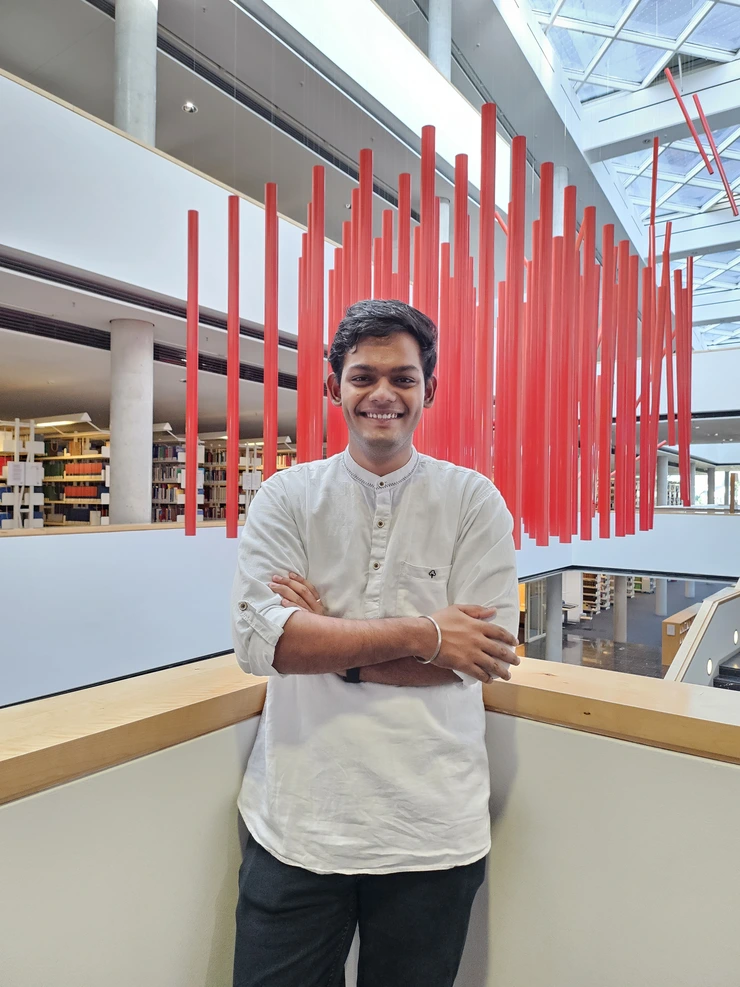
Shreesh Karmarkar is a master’s student at the Willy Brandt School of Public Policy. He holds a Bachelors degree in Political Science from the University of Mumbai. His areas of specialization are Conflict Studies and Management and Development and Socio-Economic Policies
~ The views represented in this blog post do not necessarily represent those of the Brandt School. ~